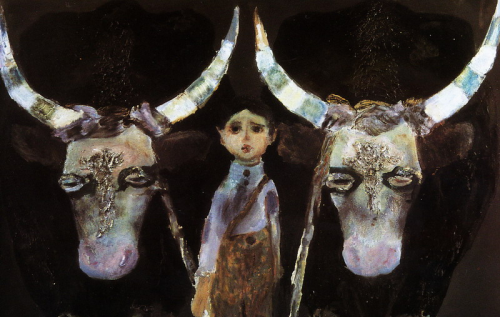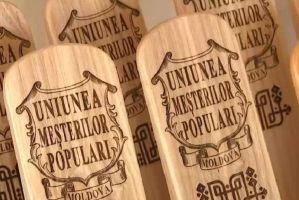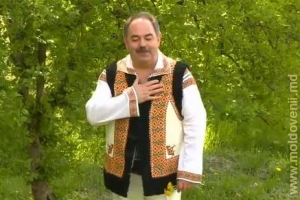 183576
183576
Fine Art

In this section you may find straightforward, comprehensive information about the development of art from ancient times to the present days. You may find out more about the works of different art genres: in prehistoric times and in the Middle Ages, as well as the contemporary works created in the territory of Moldova today. Step by step, you may learn how early forms of art were developing, about the trends and styles, which distinguish different historic epochs, find out more about the art moves having influence on the process of creation of the different art works today.
With a universal visual language art does not need a “translator”, indeed, with the help of artistic images the ideals and morals of society can be expressed. Fine art is an objective criterion of the level of culture and civilization in the corresponding historical periods.
The Moldavian term “arte plastic” comes from the Greek verb “plasticos” and Latin term “ars”, which combined in French, and made up the term “arts plastiques”.
Originally, in ancient times, this term only related to the sculpture, ceramics and architecture, during the Renaissance the term was used to describe the painting and drawing.
At the end of the XIX century, this expression was applied to all genres of fine art as a specific form of art, the result of which is the creation of works of art, that don’t have utilitarian value, but belong to the spiritual culture, forming a society tastes in the sphere of aesthetics, morality and philosophy at different times.
În contextul lansării programului ”Satul European”, ce probleme vitale există în localitatea dumneavoastră?
- Statut:
- Sat
- Prima atestare:
- 1670
- Populația:
- 163 locuitori
Balmaz este un sat din cadrul comunei Ciobanovca, raionul Anenii Noi. Localitatea se află la distanța de 15 km de orașul Anenii Noi și la 47 km de Chișinău. Conform datelor recensămîntului din anul 2004, populaţia satului constituie 163 de oameni. Satul Balmaz a fost menționat documentar în anul 1670.





 19 noiembrie - Calendarul celor mai importante evenimente din trecut și prezent
19 noiembrie - Calendarul celor mai importante evenimente din trecut și prezent  „Capodopere florale de toamnă și iarnă de la XOstudio FLOWERS: Dăruiți magia săr…
„Capodopere florale de toamnă și iarnă de la XOstudio FLOWERS: Dăruiți magia săr…  MELODIA ZILEI: The Motans și Irina Rimes - Gata De Zbor
MELODIA ZILEI: The Motans și Irina Rimes - Gata De Zbor  Corneliu Popovici despre reformele în educație: o manifestare clară a haosului d…
Corneliu Popovici despre reformele în educație: o manifestare clară a haosului d…  Moldografia: Muzeul Militar-istoric, Tighina
Moldografia: Muzeul Militar-istoric, Tighina  La mulţi ani, Nicolae Ghibu!
La mulţi ani, Nicolae Ghibu!  Stema Moldovei și portretul lui Ștefan cel Mare, pe haina reprezentantei noastre…
Stema Moldovei și portretul lui Ștefan cel Mare, pe haina reprezentantei noastre…  Roșiile conservate, leac miraculos contra atacului de cord
Roșiile conservate, leac miraculos contra atacului de cord  În capitală, a avut loc Gala Meșteșugarilor Populari din Moldova
În capitală, a avut loc Gala Meșteșugarilor Populari din Moldova  Mierea ajută la consolidarea nervilor şi memoriei
Mierea ajută la consolidarea nervilor şi memoriei  REŢETA ZILEI: Ciorbă ca la ţară
REŢETA ZILEI: Ciorbă ca la ţară  Corneliu Popovici: "Academia de Științe e vîndută pe bucăți"
Corneliu Popovici: "Academia de Științe e vîndută pe bucăți"  Istoria cinematografiei moldoveneşti
Istoria cinematografiei moldoveneşti  Alexei Petrovici: „Cei vii trebuie să apere memoria cinstită a soldaților căzuți…
Alexei Petrovici: „Cei vii trebuie să apere memoria cinstită a soldaților căzuți…  Vasile Chirtoca: „Portul Internațional Liber Giurgiulești trebuie să fie gestion…
Vasile Chirtoca: „Portul Internațional Liber Giurgiulești trebuie să fie gestion…  Defileul Trinca, Edineț (Slideshow)
Defileul Trinca, Edineț (Slideshow)  Remanieri în guvern: da vorbărie a fost..!
Remanieri în guvern: da vorbărie a fost..!  20 noiembrie - ce sărbătoare, ce evenimente, cine sînt sărbătoriți zilei de azi
20 noiembrie - ce sărbătoare, ce evenimente, cine sînt sărbătoriți zilei de azi  MELODIA ZILEI: Nicolae Paliţ - Că așa e moldoveanu
MELODIA ZILEI: Nicolae Paliţ - Că așa e moldoveanu  Alertă meteo: Ciclonul Atlantic aduce frig și ninsori în Moldova
Alertă meteo: Ciclonul Atlantic aduce frig și ninsori în Moldova 











